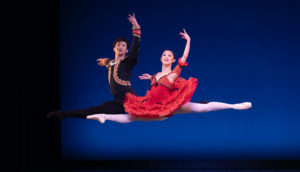Sydney’s Celebration: Australian Ballet in all-the-best-bits - Vancouver Ballet Society
- Home
- City Reports 2020 - 2023
- Sydney’s Celebration: Australian Ballet in all-the-best-bits

By Deborah Jones
The Australian Ballet’s Celebration Gala at the Sydney Opera House was greeted with unbridled enthusiasm by an audience starved for dance. End-of-year Sydney performances of Cranko’s Romeo and Juliet and Ratmansky’s Harlequinade had been cancelled, a big blow to the company following the wipe-out of its earlier programming in Melbourne, where it is based. But after a slow start, vaccination rates in Australia soared. That led to easing of COVID-19 restrictions and all of a sudden the ballet was back, albeit in stripped-back gala mode.
In a brief speech before the curtain went up on opening night, November 25, artistic director David Hallberg asked audience members to show their support for artists who have been deprived of performance for many months. They did, roaring approval for everything in a well-chosen selection of pas de deux danced by principal artists, senior artists, and soloists of the company. Not everything deserved the accolades heaped on it but the love in the room was palpable and understandable. (Melbourne gets its own Celebration Gala December 9-18 with a significantly different program.)

Apart from the obvious enjoyment to be had from an all-the-best-bits program, Celebration Gala offered seasoned ballet-goers a chance to observe who Hallberg has his eye on for certain repertoire and with what partner.
The pairing of long-serving principal artist Chengwu Guo with fast-rising talent Yuumi Yamada showed promise under what must have been testing circumstances. They had the unenviable task of opening the program in Petal Miller-Ashmole’s La Favorita, a party piece asking for arresting stage presence, stamina, and sparkle.
There is history associated with this confection. It was choreographed in 1986 for David McAllister, immediate past artistic director of the company, and Elizabeth Toohey, current ballet mistress, back when they were the liveliest dancers on the block. La Favorita made an appearance at Maina Gielgud’s farewell and at a gala when The Australian Ballet went to New York as part of its 50th anniversary celebrations. No pressure then.
A little surprisingly, it was Guo who showed some strain and Yamada who looked delightfully at home. Yamada was promoted to the middle rank of soloist this year after just four years in the company and there’s no reason she should stop there. She radiates ease and light. After his nervous start, Guo recovered to throw in one of his trademark high-flying 540s, the audience erupted, and blemishes were forgiven.

The second piece, the pas de deux from Kenneth MacMillan’s Concerto, was by far the evening’s highlight. Glorious principal artist Robyn Hendricks was partnered by Callum Linnane, a senior artist knocking loudly on the principals’ dressing-room door. The partnership between these two is special, and growing in depth and complexity. This pas de deux is an homage to the art of preparing to perform and to the support a man gives a woman in partnering. MacMillan was famously inspired by seeing Lynn Seymour at the barre and turned classroom exercises into an astonishingly sensual experience. Afterwards, I overheard a woman say she could hardly breathe during the performance. Exactly so.
The pairing of the White Swan and Black Swan pas de deux looked good on paper but was less successful in practice. In the latter, Benedicte Bemet and Brett Chynoweth gave a stunning technical display but exaggerated the acting. That will undoubtedly be tempered if we have the pleasure of them in a full production. Bemet is maturing from soubrette to star before our eyes and Chynoweth is now the most elegant stylist in the company. His elevation and cat-like landings are things of joy.
The White Swan pas de deux was a muted affair with little connection between soloist Rina Nemoto and her Siegfried, senior artist Jarryd Madden. Interestingly, later in the program Nemoto danced Christopher Wheeldon’s luscious After the Rain pas de deux with the breadth of movement and music-filling spirit her White Swan lacked. Nathan Brook supported Nemoto well in After the Rain, but both were too enigmatic in a piece that asks for a deep vein of emotion — reined in, to be sure, but it needs to be there.
What else? Imogen Chapman and Cristiano Martino knocked the pas de deux from Wayne McGregor’s Chroma out of the park, and the audience adored Karen Nanasca and Brook in a duo from Alice Topp’s Logos. Sharni Spencer — another to watch — was delightful as Valencienne in The Merry Widow excerpt with Christopher Rodgers-Wilson, and Bemet and Guo brought it home with the grand pas de deux from Peter Wright’s The Nutcracker.
On the debit side, it was noticeable that not all the men looked entirely match fit when it came to partnering. Roll on 2022.
The Opera Australia Orchestra had a good night in the pit, fronted by Nicolette Fraillon. She has just announced that after two decades in the role she will leave as The Australian Ballet’s music director and chief conductor at the end of next year, and will be a hard act to follow.
The evening started with the rollicking fanfare Les chasseresses from Delibes’ ballet Sylvia. Among the musical highlights were a heart-swelling White Swan, Shostakovich’s second piano concerto for MacMillan’s Concerto with Duncan Salton as soloist, and Ilya Demutsky’s new score for Yuri Possokhov’s Anna Karenina. Hendricks and Linnane danced the pas de deux in which Vronsky starts drawing away from a despairing Anna, giving a powerful taste of the ballet ahead of its 2022 seasons in Melbourne (February 25-March 9) and Sydney (April 5-23).

